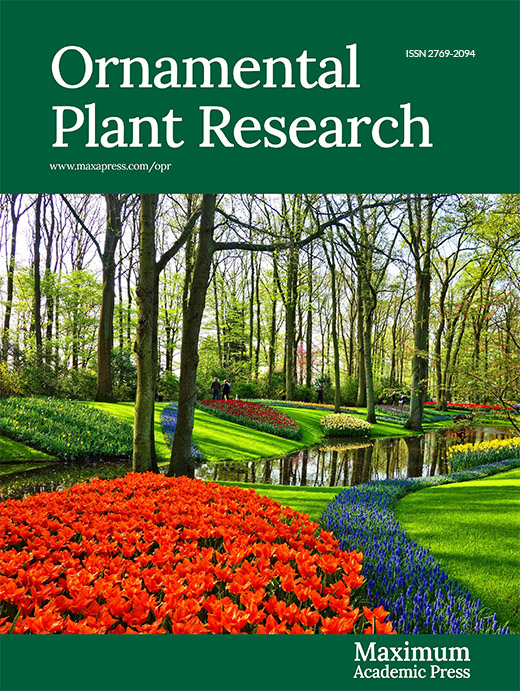-
I am honored and pleased to introduce a new international, open access, online-only journal − Ornamental Plant Research (OPR) through this inaugural editorial.
Ornamental plants are those that are grown for decoration and beautification of indoor and outdoor environments. Plants from over 2,000 genera are used as ornamental plants, which are divided into floriculture crops, ornamental shrubs, trees, grasses, and bamboos as well as ornamental aquatic plants. Based on the USDA Floriculture Crops 2018 Summary[1], floriculture crops are referred to as bedding/garden plants, potted herbaceous perennials, potted flowering plants, foliage plants (commonly known as houseplants), cut flowers, and cut greens. Ornamental trees and shrubs encompass a diverse group of woody plants used in gardens, parks, and landscape settings. Ornamental grasses and bamboos are monocots that bring a sense of tranquility in gardens, yards, and parks. Ornamental aquatic plants include lotus, water lilies, reeds, primrose, and hyacinths.
The value of ornamental plants relies on their aesthetic appearance, including pleasing flower and/or leaf color, flower and/or leaf shape, fragrance, leaf texture and variegation, and overall plant form or architecture. Ornamental plants have been grown for centuries and are frequently associated with cultural symbols. Roses were first cultivated by the Chinese 5000 years ago[2]. Egyptians used blue lotus (Nymphae nouchali var. careulea), dwarf palm (Chamaerops humilis), and the papyrus (Cyperus papyrus) as motives in temples and buildings as early as 2800 BC[3]. In Europe, throughout the Christian era, roses were scattered in churches to commemorate the gift of the Holy Spirit. The white lily (Lilium candidatum) was a symbol of the Virgin Mary’s piety and virtue[3]. The Botanical Garden of Padua was created in 1545 and is still active, and now there are more than 2,500 botanical gardens in the world conserving and cultivating six million accessions of living plants and playing an important role in education, scientific research, and public engagement[4]. Ornamental plants are not nonessential luxuries, but an integral part of contemporary design. Gardening is growing as the number one hobby in the United States (U.S.), and ornamental plants play a critical role in our lives to stimulate the imagination, revive the spirit, enhance memory retention and concentration, and significantly improve metal health and human well-being.
The ornamental plant industry is a fast-growing sector in world agriculture. For example, ornamental plants represent the sixth largest agricultural commodity group in the U.S., of which the wholesale value of floriculture crops only was 4.6 billion in 2018 in the U.S.[1]. The European Union (EU) is one of the most important regions for the production of ornamental plants with a production value of 17.1 billion euro[3]. China has also gained momentum in ornamental plant research and production. Ornamental production acreage was 1,392,293 hectares in 2017, which was a 1.5-time increase compared to 2010, and the wholesale value was 153.3 billion Chinese Yuan in 2017, a 1.8-time increase compared to 2010 (Sumei Chen, pers. Comm). Ornamental plant production has also been expanding rapidly in Latin America, particularly Columbia, Ecuador, and Brazil, and in Africa, such as Ethiopia and Kenya. Recent annual growth in Brazil has been 6.26%. All said, ornamental plant production is blooming around the world.
The diversity and multipurpose use of ornamental plants along with their increasing production worldwide require more fundamental research on their growth and development, flower and leaf colors, fragrance, and growth form. Current research on ornamental plants is largely focused on methods or techniques for improving propagation, production, and postharvest or postproduction handling. Basic research on genetics, molecular biology, biochemistry and physiology of ornamental plants is behind that of field crops and even other horticultural crops. Fundamental research explores underlying mechanisms behind specific phenomena; it fuels technological advances of the ornamental plant industry, such as the development of blue rose[5]. I believe that promoting basic research on ornamental plants will improve our understanding of various unique phenomena in ornamental plants and accelerate the development of innovative technologies for better production and utilization of ornamental plants.
Ornamental plants are also unique experimental materials for understanding scientific questions. Why do cactus species tolerate heat and drought? Why can carnivorous plants catch and digest small insects for their nutrition? Why can foliage plants grow and tolerate low light? Why can manipulation of soil pH change flower colors of Hydrangea but not the flower color of rose plants? Why do species from the genus Chimonanthus flower in the snowy winter? Can we eventually create true blue roses? Can we make tropical ornamental plants more tolerant to chilling temperatures? Can we create plants that repel insect pests? How can foliage plants improve our mental health and well-being? The recent releases of more than 40 ornamental species genomes surely will help to solve these mysteries. Furthermore, genomic sequence information will allow breeders to create novel plants and/or desirable characteristics of ornamental plants through genomic editing and DNA-informed breeding.
Ornamental Plant Research aims to publish fundamental research that represents significant advances or new insights into our understanding of specialized areas of ornamental plants. The areas include genetics, epigenetic, genomics, and cytogenetics and their utilization for improving ornamental characteristics; ecology, evolution, and domestication of ornamental plants; biotechnological approaches for creating novel ornamental traits or improving fragrance; plant and microbe interactions for improving plant productivity; genetic and molecular bases underlying plant resistance or tolerance to pathogens, insect pests or abiotic stresses; fundamental research on the use of ornamental plants in improvement of indoor and outdoor environments and remediation of mental health and well-being. OPR will also publish review articles that provide comprehensive and critical reviews of current research areas and offer directions and perspectives for future research. Additionally, the journal will publish applied research that has significant implications for the development of the ornamental industry. In short, OPR will provide a forum for researchers all over the world to discuss and communicate cutting-edge development in ornamental plant research.
I would like to thank Maximum Academic Press for inviting me to be the founding Editor-in-Chief of this journal. I accepted the invitation and will work diligently with the publisher and the Associate Editors (AEs) to develop OPR into a premier journal in ornamental plant research. I would like to thank all the AEs for their willingness to devote their time and expertise to serve this journal. Manuscripts submitted to OPR will be initially reviewed by the editorial office for format, and I will conduct a quick review for scientific soundness. Manuscripts that have passed these two steps will be assigned to AEs to invite colleagues to conduct peer reviews. I will heavily depend on our AEs to handle and review manuscripts and make sound recommendations on each manuscript. Thus, all manuscripts will undergo a critical review, which will be guided by the high standards of scientific quality and integrity as well as professional responsibility. Submitted manuscripts are expected to be handled in a timely fashion for quick revision turn-around if the paper is deemed suitable for publication, and I expect to see the final articles online and available for the public to read in far less time than with more traditional journals.
In close, I am looking forward to heading this amazing effort and new publication. I encourage scientists who are engaged in basic studies of ornamental plants to submit their valuable work to this journal. I appreciate your recommendations and suggestions and hope this journal will be a part of the community effort to help shape the future of ornamental plant research. With your support, together we can build a journal of excellence to serve the ornamental plant research community, and agricultural and biological sciences in general.
HTML
- The authors declare that they have no conflict of interest.
- Copyright: © 2021 by the author(s). Exclusive Licensee Maximum Academic Press, Fayetteville, GA. This article is an open access article distributed under Creative Commons Attribution License (CC BY 4.0), visit https://creativecommons.org/licenses/by/4.0/.
|
|












